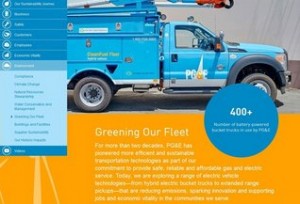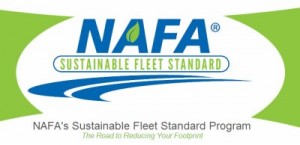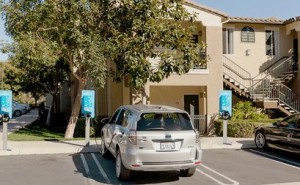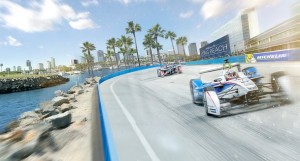by Jon LeSage, editor and publisher, Green Auto Market
Here’s my take on the 10 most significant and interesting occurrences during the past week…….
 Clean transportation product launches coming up: Ford, Cummins Westport, the North American Council on Freight Efficiency (NACFE), Rush Enterprises, Alliance AutoGas, ClipperCreek, Parker, Bauer Compressor, Quantum Technologies, Superior Transportation Solutions, and other companies will be introducing new alternative fuel and clean vehicle technologies at the Alternative Clean Transportation (ACT) Expo. Event organizer Gladstein, Neandross and Associates (GNA) expects that more than 3,500 clean transportation stakeholders and 200 plus exhibitors will convene May 4-7 at the Kay Bailey Hutchison Convention Center in Dallas for ACT Expo, the industry’s largest annual alternative fuel conference and expo. “As the transportation industry faces volatile oil prices and continually tightening emissions regulations, it’s vital for fleet operators to understand the wide range of options available—including electric, hybrid, hydrogen, natural gas, propane autogas, renewable fuels, DME, clean diesel, and efficiency technologies,” said GNA CEO Erik Neandross.
Clean transportation product launches coming up: Ford, Cummins Westport, the North American Council on Freight Efficiency (NACFE), Rush Enterprises, Alliance AutoGas, ClipperCreek, Parker, Bauer Compressor, Quantum Technologies, Superior Transportation Solutions, and other companies will be introducing new alternative fuel and clean vehicle technologies at the Alternative Clean Transportation (ACT) Expo. Event organizer Gladstein, Neandross and Associates (GNA) expects that more than 3,500 clean transportation stakeholders and 200 plus exhibitors will convene May 4-7 at the Kay Bailey Hutchison Convention Center in Dallas for ACT Expo, the industry’s largest annual alternative fuel conference and expo. “As the transportation industry faces volatile oil prices and continually tightening emissions regulations, it’s vital for fleet operators to understand the wide range of options available—including electric, hybrid, hydrogen, natural gas, propane autogas, renewable fuels, DME, clean diesel, and efficiency technologies,” said GNA CEO Erik Neandross.- Enterprise and Trucking Moves America Forward Honor Earth Day: With the 45th annual Earth Day taking place on April 22, Enterprise Rent-A-Car announced its contribution for the 10th consecutive year to the Arbor Day Foundation. The Foundation uses funding from the Enterprise Rent-A-Car Foundation to plant one million trees throughout the US, Canada, the United Kingdom, and Germany as part of the Enterprise 50 Million Tree Pledge. By the end of 2015, 10 million trees will have been planted through the program in forests through this unique public-private partnership, which – in addition to the Arbor Day Foundation – also includes the US Forest Service, US National Park Service, Tree Canada, Trees Ontario, the U.K.’s Woodland Trust and the German Forest Protection Association (Schutzgemeinschaft Deutscher Wald). Trucking Moves America Forward (TMAF), the industry-wide image and education movement representing all areas of the professional truck driving industry, honored Earth Day by celebrating the progress the trucking industry is making toward a more sustainable future, which includes adopting industry recommendations to reduce carbon emissions. Some of the many programs, efforts and technologies that trucking companies and drivers support include: training that emphasizes fuel-saving driving techniques; reducing wait times at loading and unloading docks to decrease engine idling emissions; reducing pollution through ongoing participation in the EPA SmartWay Transport Partnership program; advancing alternative-fueled vehicles and fuels; lowering fuel consumption by reducing empty miles driven; and promoting more efficient freight hauling and freight packaging practices.
- Tesla-rama: Hackers took on Tesla Motors by attacking its Twitter site and media-relations email account on Saturday. Tesla joins Sony Pictures and several other companies in getting hacked; in this situation, the hackers who entered Tesla’s Twitter feed were able to post messages to the company’s more than 564,000 followers, and one of the attackers responded to an email message to Tesla’s press contact……….. JB Straubel, co-founder and CTO of Tesla Motors, will be a keynote speaker at the 2015 EIA Energy Conference. The U.S. Energy Information Administration (EIA) will hold the conference on June 15 and 16 at the Renaissance Downtown Hotel in Washington, DC………. Tesla CEO Elon Musk only earned $35,360 from his Tesla paycheck last year; however, Musk has done very well with his Tesla stock portfolio over the past two years and from his salary at SpaceX, the private rocket launching service he also founded.
- No more Bullsh*t about hydrogen: As Toyota begins production of its Mirai hydrogen fuel cell car, the automaker is taking on hydrogen critics. It’s the most abundant element in the universe, but critics say that hydrogen fuel cells are not going to work as a viable alternative energy for transportation – it’s dead on arrival. Those that call it “bullsh*t” are right, but not in the way they think, the Toyota video says. Manure provides an enormous amount of energy, as do water and other sources, explains Toyota engineer Scott Blanchet while visiting a farm.
- Audi plug-in hybrids: Audi believes plug-in hybrids are the best alternative to offer customers, and will be making that option a preferred choice for customers on several models over the next 10-to-15 years. First up will be a full-electric model – an Audi SUV with a 310-mile range that will take on Tesla’s upcoming Model X crossover, says CEO Rupert Stadler.
- Americans support RFS: Renewable Fuel Association just paid for a consumer survey and found there’s bipartisan, majority support for the Renewable Fuel Standard. More than six in 10 Americans support it with Democrats at 65%, Independents at 61%, and Republicans at 57%. Less than two in 10 oppose it, and 20% have no opinion. Now it’s time for the US Environmental Protection Agency to release its volume standards.
- Allied Specialty Vehicles has CNG and Propane partnerships: Big announcements from Allied Specialty Vehicles (ASV), a maker of vehicles for commercial, fire and emergency, and recreation markets……… ASV has an exclusive partnership with Westport to expand availability of the compressed natural gas (CNG) Westport WiNG™ Power System beyond school buses manufactured by Collins Bus; the CNG system will be added to commercial bus, emergency, and other vehicle products. A week earlier, ASV announced its exclusive partnership with CleanFUEL USA to expand its lineup of propane autogas products. ASV will move beyond propane-powered Collins Bus school buses to “increase the breadth of propane autogas systems we can offer to our customers,” said Tim Sullivan, ASV president and CEO.
- BMW adding to i series: BMW is adding to its plug-in electric i subbrand with the i5, which will be based on its 5 series. BMW will begin selling the i5 in 2018 and expects that it could be its best-selling i model. The plug-in hybrid executive sedan will have a gasoline engine and two electric motors.
- Quantum adding to offerings: Quantum Fuel Systems Technologies Worldwide, Inc., is expanding its offerings beyond natural gas storage systems and plug-in hybrid F150s – hydrogen fueling dispensers. Quantum received multiple orders from Linde North America to develop and manufacture retail hydrogen fueling dispensers for the further development of hydrogen fueling infrastructure in California, which should be delivered by the fourth quarter of 2015.
- EV used vehicle values: NADA Used Car Guide’s Perspective: Electric Vehicle Retention Report Card was just released this morning. Here’s part of it: “For the most part, used EV prices continue to be very soft, which really isn’t much of a departure from how prices have tracked over the past couple of years. Used EV demand continues to be hampered by range and technology concerns, as well as by stiff competition from highly efficient—and more affordable—gasoline-powered cars.” Top performers on the list are the Tesla Model S at 83.1% retention value and Porsche Panamera S-E at 78.4% retention value. The Nissan Leaf is near the bottom of the list at 43.5% retention value.







